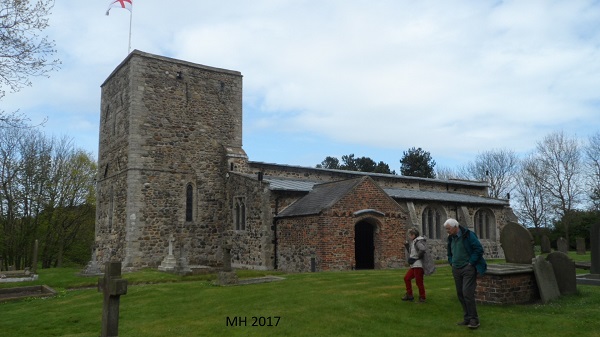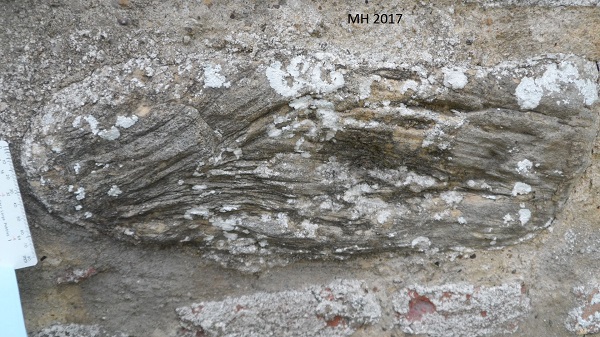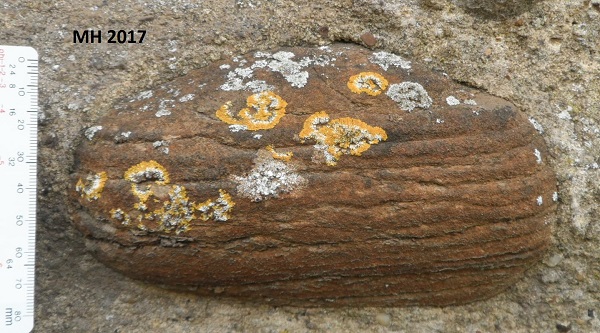

Humberside Geologist no 16
(published 2019)
The Geology and Lichens of Saint Michael’s Church, Garton, East Yorkshire.
By Mark Seaward and Mike Horne.

St Michael’s church in Holderness
(NGR TA271355) can be found between
Garton and Grimston and is about a kilometre from the sea. It is mostly built of
erratic boulders probably collected from the fields or the beach. The stonework
on the corners of the building is probably a Jurassic oolitic limestone and the
buttresses on the south of the building are probably Magnesian Limestone. There
is a porch built from medieval bricks which were probably made locally. This
provides a wide variety of rock substrates for lichen.
Geology -
Here is a description of some of the erratic rocks
that can be seen on the outside of the Church, if you wander in an anticlockwise
direction starting at the porch:
South side – ironstone, basalt, Middle Jurassic
sandstone, red chalk, Gryphaea, grey
mudrock (weathering badly), quartzite and lichens were seen on a buttress of
dressed Magnesian Limestone

East end – Old Red Sandstone (Devonian), New Red
Sandstone (Peron-Triassic), cross-bedded grey sandstone and Magnesian Limestone

North Side – vesicular basalt, locally made brick,
pink granite, red sandstone, dolerite, bioturbated sandstone, Brockram, grey
flint (Yorkshire flint from the Chalk), Larvikite (from Larvik in Norway), pink
gneiss, grey gneiss and Jurassic oolite
(dressed stone making the surround to the north doorway)

West wall of tower- porphyry, corals in grey
limestone, Gryphaea in shelly Jurassic
limestone, grey sandstone (ganister?) and small pectenids and oysters in
limestone
South wall of tower and west side of the porch –
large Pecten in Jurassic ironstone,
Chalk, septarian nodule, grey granite, New Red Sandstone, cross bedded Middle
Jurassic sandstone and Carboniferous grey gritstone.
Inside the church – there is an
old altar of pale red sandstone.
The graves in the churchyard are mostly “York
Stone” (Middle and Upper Carboniferous sandstones from the West Riding). There
are some more modern monuments including the following stones -
Larvikite, coarse grained grey granite,
medium grained grey granite, red sandstone and Carrara
Marble (from Italy).
The perimeter wall of the churchyard includes a
variety of erratics including Chalk and is capped by brickwork.

The descriptions of the rocks are mostly generic
and made from a quick visual inspection. No chemical tests were made and no
samples taken.
Lichenology -
This basic survey demonstrated the value of
lichens in environmental monitoring, on this occasion highlighting their
preferences for particular substrata and the impact of over-riding factors such
as the spread of nitrogenous compounds. Although relatively close to the sea,
maritime effects on the lichen flora were hardly noticeable. The N, S, E and W
walls of the church supported different lichen assemblages; however, the
vertical gravestones generally lacked differences in the lichen assemblages on
the E and W faces as would be expected, but their apices occasionally supported
ornithocoprophilous lichens.
Of the
43 lichen species recorded above only 35 were found on the stonework (7 were on
trees, 1 was on a metal gate, and 1 on a pebbled pathway). The church and
gravestones supported 21 and 25 species respectively and, in the case of the
latter, 14 were found on siliceous substrata and 11 on calcareous substrata.
There are no unusual or uncommon species on the list but time did not permit for
a thorough investigation that would most probably double the number of species
in the tally and may include some locally uncommon species.
In the following list, the numbers after each entry refer to the number of 10 km
x 10 km grid squares (max. 195) in which the species occurs in Yorkshire,
followed by the number (in parentheses) from which it has disappeared; thus
Lecanora chlarotera, for example, occurs in 116 squares, has
disappeared from 11, and has never been recorded from 68. The level of
extinction, of considerable importance to conservation studies, can therefore be
determined from these figures, but for many species our knowledge is imperfect
due to taxonomic misapplication in the past or recent taxonomic segregation
demanding reinterpretation of records for which limited herbarium material
exists.
Substrates and habitats studied:
B – brick wall to W of churchyard
C – church (N, S, E & W walls mentioned where
significant)
GC – calcareous gravestones
GS – siliceous gravestones
M – iron gate
P – compacted soil on pebbled pathway
T – deciduous trees to N of churchyard
[N] – nitrophytes
Acarospora fuscata
(Schrad.) Th.Fr. 185(0) GS
Amandinea punctata
(Hoffm.) Coppins & Scheid. 141(3) T
Aspicilia calcarea
(L.) Körb. 120(3) C & GC
Bilimbia sabuletorum
(Schreb.) Arnold 111(3) C (N wall – on mosses)
Buellia aethalea
(Ach.) Th.Fr. 118(0) GS
Caloplaca aurantia
(Pers.) Hellb. 50(7) C (S & E walls) & horizontal cementwork
of a single grave
C. chrysodeta (Vain. ex Räsänen) Dombr.
50(0) C
C. citrina (Hoffm.) Th.Fr. [s.lat.]
194(1) C & GC
C. flavescens (Huds.) J.R.Laundon
156(1) C & GC
C. flavocitrina
(Nyl.) H.Olivier 49(0) C (calcareous stonework only) & GC
C. saxicola (Hoffm.) Nordin
131(5) C (calcareous stonework only)
C. teicholyta (Ach.) J.Steiner
70(0) C (calcareous stonework only)
Candelariella vitellina
(Hoffm.) Müll.Arg. 192(1) GS [N]
Collema tenax (Sw.) Ach. var. var.
ceranoides (Borrer) Degel. 41(5) P
Diploicia canescens
(Dicks.) A.Massal. 117(9) C (S wall) & T [N]
Haematomma ochroleucum
(Neck.) J.R.Laundon var. ochroleucum 80(1) GS
Lecanora albescens
(Hoffm.) Branth & Rostr. 172(3) C & GC
L. campestris (Schaer.) Hue 167(1)
C & GS
L. chlarotera Nyl. 116(11)
T
L. crenulata Hook. 108(6)
C
L. dispersa (Pers.) Sommerf.
194(0) C & GC
L. expallens Ach. 143(2)
GS & T
L. muralis (Schreb.) Rabenh.
183(0) GS (relaid horizontally)
L. orosthea (Ach.) Ach. 121(0)
GS
L. polytropa (Hoffm.) Rabenh.
190(0) GS
L. soralifera (Suza) Räsänen
165(0) GS
Lecidella elaeochroma
(Ach.) M.Choisy 81(13) T
L. scabra (Taylor) Hertel & Leuckert
175(0) GS
L. stigmatea (Ach.) Hertel & Leuckert
172(1) GC
Lepraria incana
(L.) Ach. [s.lat.] 194(0) C (N wall) & GS
Opegrapha calcarea
Turner ex Sm. 79(7) C (N wall)
Phaeophyscia orbicularis
(Neck.) Moberg 184(0) T
Physcia adscendens
(Fr.) H.Olivier 180(1) GC, M & T [N]
P. tenella (Scop.) DC. 164(4)
T
Porpidia tuberculosa
(Sm.) Hertel & Knoph 183(0) C & GS
Psilolechia lucida
(Ach.) M.Choisy 181(0) GS
Sarcogyne regularis
Körb. 115(3) C
Tephromela atra
(Huds.) Hafellner ex Kalb 136(8) C & B
Toninia aromatica
(Sm.) A.Massal. 105(7) B (cementwork between bricks)
Verrucaria muralis
Ach. 177(2) C & GC
V. nigrescens Pers. 181(0)
C & GC
Xanthoria parietina
(L.) Th.Fr. 188(1) T [N]
X. polycarpa (Hoffm.) Th.Fr. ex Rieber
122(3) M [N]
These notes were compiled with the help of Stuart
Jones on a field trip of the Hull Geological Society to record the lichen and
geology on 22nd April 2017. We thank Lif Marriott and Paul Fisher for
facilitating our visit.